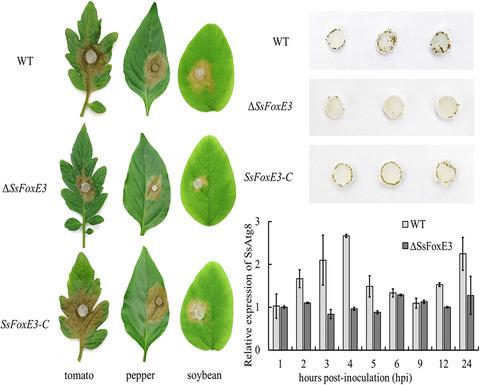当前位置:
X-MOL 学术
›
Mol. Plant Pathol.
›
论文详情
Our official English website, www.x-mol.net, welcomes your
feedback! (Note: you will need to create a separate account there.)
Transcription factor SsFoxE3 activating SsAtg8 is critical for sclerotia, compound appressoria formation, and pathogenicity in Sclerotinia sclerotiorum
Molecular Plant Pathology ( IF 4.8 ) Pub Date : 2021-10-26 , DOI: 10.1111/mpp.13154 Wenli Jiao 1 , Huilin Yu 1 , Jie Cong 1 , Kunqin Xiao 1 , Xianghui Zhang 1 , Jinliang Liu 1 , Yanhua Zhang 1 , Hongyu Pan 1
Molecular Plant Pathology ( IF 4.8 ) Pub Date : 2021-10-26 , DOI: 10.1111/mpp.13154 Wenli Jiao 1 , Huilin Yu 1 , Jie Cong 1 , Kunqin Xiao 1 , Xianghui Zhang 1 , Jinliang Liu 1 , Yanhua Zhang 1 , Hongyu Pan 1
Affiliation

|
Sclerotinia sclerotiorum, the notorious necrotrophic phytopathogenic fungus with wide distribution, is responsible for sclerotium disease in more than 600 plant species, including many economic crops such as soybean, oilseed rape, and sunflower. The compound appressorium is a crucial multicellular infection structure that is a prerequisite for infecting healthy tissues. Previously, the Forkhead-box family transcription factors (FOX TFs) SsFoxE2 and SsFKH1 were shown to play a key regulatory role in the hyphae growth, sexual reproduction, and pathogenicity of S. sclerotiorum. However, little is known about the roles of SsFoxE3 regulating growth and development and pathogenicity. Here, we report SsFoxE3 contributes to sclerotium formation and deletion of SsFoxE3 leads to reduced formation of compound appressoria and developmental delays. Transcripts of SsFoxE3 were greatly increased during the initial stage of infection and SsFoxE3 deficiency reduced virulence on the host, while stabbing inoculation could partially restore pathogenicity. The SsFoxE3 mutant showed sensitivity to H2O2, and the expression of reactive oxygen species detoxification and autophagy-related genes were reduced. Moreover, expression of SsAtg8 was also decreased during the infection process of the SsFoxE3 mutant. Yeast 1-hybrid tests suggested that SsFoxE3 interacted with the promoter of SsAtg8. Disruption of SsAtg8 resulted in a phenotype similar to that of the SsFoxE3 mutant. Comparative analysis of the level of autophagy in the wild type and SsFoxE3 mutant showed that N starvation-induced autophagy was reduced in the SsFoxE3 mutant. Taken together, our findings indicate that SsFoxE3 plays an important role in compound appressorium formation and is involved in transcriptional activation of SsAtg8 during infection by S. sclerotiorum.
中文翻译:

转录因子 SsFoxE3 激活 SsAtg8 对核盘菌的菌核、复合附着胞形成和致病性至关重要
核盘菌是臭名昭著的坏死性植物病原真菌,分布广泛,可引起 600 多种植物的菌核病,包括大豆、油菜和向日葵等许多经济作物。复合附着胞是一种重要的多细胞感染结构,是感染健康组织的先决条件。以前,叉头盒家族转录因子 (FOX TFs) SsFoxE2 和 SsFKH1 被证明在核盘菌的菌丝生长、有性繁殖和致病性中起关键调节作用。然而,关于 SsFoxE3 调节生长发育和致病性的作用知之甚少。在这里,我们报告SsFoxE3有助于菌核的形成和缺失SsFoxE3导致复合附着物的形成减少和发育迟缓。SsFoxE3转录本在感染初期大大增加,SsFoxE3缺乏降低了对宿主的毒力,而刺杀接种可以部分恢复致病性。SsFoxE3突变体对H 2 O 2表现出敏感性,活性氧解毒和自噬相关基因的表达降低。此外,在SsFoxE3突变体的感染过程中,SsAtg8 的表达也降低了。酵母 1 杂交试验表明 SsFoxE3 与 SsAtg8 的启动子相互作用. SsAtg8的破坏导致类似于SsFoxE3突变体的表型。野生型和SsFoxE3突变体自噬水平的比较分析表明, SsFoxE3突变体中 N 饥饿诱导的自噬减少。总之,我们的研究结果表明,SsFoxE3 在复合附着胞形成中起重要作用,并在核盘菌感染期间参与SsAtg8的转录激活。
更新日期:2021-10-26
中文翻译:

转录因子 SsFoxE3 激活 SsAtg8 对核盘菌的菌核、复合附着胞形成和致病性至关重要
核盘菌是臭名昭著的坏死性植物病原真菌,分布广泛,可引起 600 多种植物的菌核病,包括大豆、油菜和向日葵等许多经济作物。复合附着胞是一种重要的多细胞感染结构,是感染健康组织的先决条件。以前,叉头盒家族转录因子 (FOX TFs) SsFoxE2 和 SsFKH1 被证明在核盘菌的菌丝生长、有性繁殖和致病性中起关键调节作用。然而,关于 SsFoxE3 调节生长发育和致病性的作用知之甚少。在这里,我们报告SsFoxE3有助于菌核的形成和缺失SsFoxE3导致复合附着物的形成减少和发育迟缓。SsFoxE3转录本在感染初期大大增加,SsFoxE3缺乏降低了对宿主的毒力,而刺杀接种可以部分恢复致病性。SsFoxE3突变体对H 2 O 2表现出敏感性,活性氧解毒和自噬相关基因的表达降低。此外,在SsFoxE3突变体的感染过程中,SsAtg8 的表达也降低了。酵母 1 杂交试验表明 SsFoxE3 与 SsAtg8 的启动子相互作用. SsAtg8的破坏导致类似于SsFoxE3突变体的表型。野生型和SsFoxE3突变体自噬水平的比较分析表明, SsFoxE3突变体中 N 饥饿诱导的自噬减少。总之,我们的研究结果表明,SsFoxE3 在复合附着胞形成中起重要作用,并在核盘菌感染期间参与SsAtg8的转录激活。





















































 京公网安备 11010802027423号
京公网安备 11010802027423号